Last week, we were talking about the forgotten heroes of World War II comics, Hillman’s Airfighters, and their star attraction, Airboy, a kid pilot with an amazing robot plane named Birdie. Let us continue:
In time, Airboy becomes an authorized if unofficial member of the Air Force, often going out on missions at the behest of the War Department. For young readers at the time, Airboy was bound to be a hit. Rather than the “sidekick” role that kids appeared in over at National and Timely, here the kid was the star, and not in a small way, either. He was shooting down Nazis and Japanese Zeroes and being treated like an equal by soldiers and generals. Forget being a sidekick, this was wish fulfillment! And the appeal of Birdie was huge. In later issues, a radio link was incorporated so that Airboy could call Birdie to come pick him up, and over time, this link between Airboy and Birdie was subtly stressed to such a degree that Birdie almost seemed alive, and would swoop down to save Airboy time and time again, snatching Airboy between his front tires like a bird’s talons.
The creators were also smart enough to allow Airboy to grow older with the readers, so that while he looked to be about 12 when the series started in 1942, by the time the series ended in the ‘50s, Davy looked closer to 18 or so. Which was good, considering that he had one of the sexiest femmes fatales in all of comics on his hands: the German aviatrix Valkyrie. Val first appeared as an enemy of Airboy’s, a Nazi fighter pilot who led a band of female Luftwaffe fighters called the Airmaidens.
With each successive appearance in the series (usually drawn by Fred Kida), Val became more sympathetic and the attraction between Val and Airboy became more pronounced, and soon she had defected from the Reich and was fighting alongside Airboy with the Allies. Along with Birdie, the Airboy-Valkyrie romance is one of the most fondly remembered aspects of the Airboy feature.
Although Airboy primarily fought foreign spies and pilots (and after the war, even common crooks and bankrobbers), his creepiest adversary was Misery. Misery was, plain and simple, a demon who hungered for the souls of aviators, and longed to add Airboy to the doomed souls he kept trapped aboard his Airtomb, a mold-encrusted Flying Fortress of damnation. I realize it sounds silly in print, but it was some spooky stuff.
By issue #23 AIR FIGHTERS COMICS had changed its name to AIRBOY COMICS, and remained popular even after the end of World War II. AIRBOY COMICS ran until May 1953, when Hillman, like many other publishers, got out of the comic-book business due to declining sales.
And for 30 years or so, Airboy and the Air Fighters remained in limbo, fondly remembered. Until 1986, that is.
In ’86, indie comics publisher Eclipse Comics acquired the rights to the Hillman characters, and brought them back in a big way, in what I consider one of the most creatively successful revivals of any Golden Age character. In the hands of writer Chuck Dixon (some of his first comics work, I believe) and artists Tim Truman and Stan Woch, and overseen by editor cat yronwode, the new AIRBOY series wove all the elements of the Hillman AIR FIGHTERS comics together in a modern setting. Normally, I try not to spoil too much of the comics I discuss here, but since these comics are long out of print and no trades are available, I’ll just give you the set-up for the series’ revival, and hopefully inspire you to go dive though the back-issue bins of your next comic convention to find these lost gems.
When the story picked up in ’86, we discover that former Airboy Davy Nelson is now CEO of Nelson Aviation, an airplane company that now deals primarily in munitions. Or at least he was. As the story opens, he’s dead, from a self-inflicted gunshot wound. Davy’s son, David Nelson III, soon discovers his father’s past as Airboy from his tutor and flight instructor Hirote, who, it turns out, had come to work for David’s father after the war in a mutual showing of respect. Hirote practically raised David on the Nelson Estates where Brother Martier’s monastery once stood, after the death of David’s mother. In further investigating the death of his father, David meets more of his father’s old friends: Sky Wolf, now a grizzled old soldier of fortune who’s taken to piloting a attack helicopter (he’d long since given up the wolf pelt on his head, opting for a cooler leather mask); the Iron Ace, who was nearly killed as a test pilot and has lived in hiding beneath the Nelson Estates for years, now more machine than man; and the Heap, who in his simple-minded state mistakes David for his father when he’s wearing his father’s old Airboy uniform.
David even recovers and restores the long-neglected Birdie, returning him to his former glory. In time, they discover the reason that David’s father had killed himself: he was being blackmailed by Misery, who was holding captive the one thing that Davy held most dear: his beloved Valkyrie, frozen in time for three decades. David, Hirote and Sky Wolf manage to recover Valkyrie from Misery’s clutches, and she awakes, 30 years out of place, and immediately transfers all of her affection for the original Airboy onto his son, a prospect which both excites and repels young David.
The Dixon AIRBOY run was quite successful for a while, spawning a number of miniseries and specials. Over time the new Airboy dealt with matters both political and mystical, from the overthrow of a banana republic propped up by his father’s weapons, to the desperate flight to stop another WW II-era atomic bomb headed for Russia, shanghaied for decades by Misery. In time, David and Val reconciled their initial awkwardness and somewhat unhealthy relationship into a genuine romance, handled with wit, heart and a light touch by scripter Dixon. The series ended in 1989 after 50 issues (in the middle of a cliffhanger that revealed the fate of the long-absent Flying Dutchman, a fact that drives me crazy to this day), and Eclipse Comics ended not long after, the victim of poor management and a messy divorce between its principal owners. Later, most of the Eclipse assets, including the Airboy characters, were purchased by Todd McFarlane, who has did nothing with them, save the use of the “Heap” name on a similar character in his Spawn comic book and action-figure line. They’ve all fallen into the public domain now, as evidenced by Image’s recent and rather unsavory use of the character.
Anybody looking for some good back issues during this summer’s convention season could do much worse than putting together a complete set of the Eclipse AIRBOY comics, or even easier, pick up IDW’s recently released collections of the Eclipse run. Highly recommended.

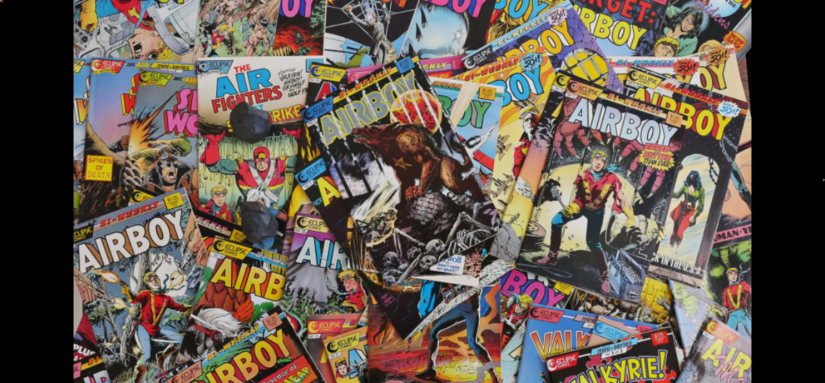
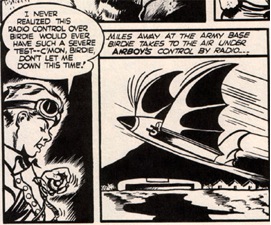

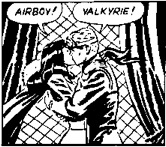
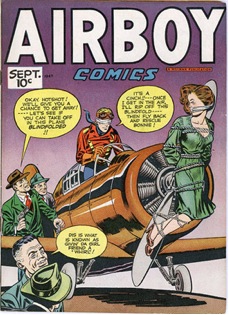
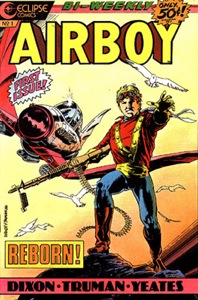

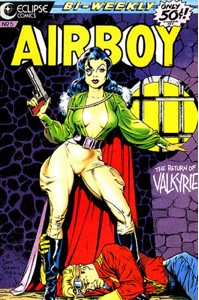

Comments are closed.